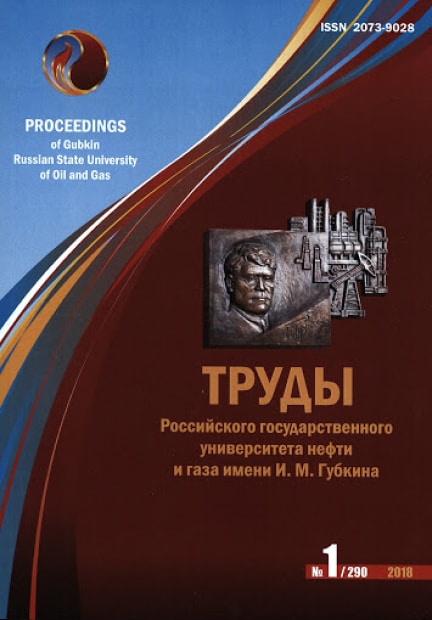Scientific and technical journal
«Proceedings of Gubkin University»
ISSN 2073-9028

ASPECTS OF CALCULATING FREE ENERGY OF DROP ON SOLID SURFACE
UDC: 547
DOI: 10.33285/2073-9028-2020-4(301)-141-148
Authors:
1 Shukhov Belgorod State Technological University, Belgorod, Russian Federation
Keywords: Young’s equation, the boundary angles of wetting, the parametric model of wetting, isobaric-isothermal potentia
Annotation:
The analysis of the wetting model based on the measurement of the areas of the interface of the contacting phases: liquid-gas, solid-gas, solid-liquid is carried out. It is shown that the calculations of the Isobaric-isothermal potential Δ F during wetting must take into account all the main components of the surface energies (the free energy of the drop before the wetting process); this condition is rather important if the variational principle of the minimum energy is not realized in the process of wetting - the shape of the drop before the wetting process is not spherical, and the wetting process is not equilibrium, or it is necessary to take into account the forces of gravity at large drop sizes, and for a water drop with a small radius (less than 0.5 mm), all cases of wetting can be interpreted by representing the drop as a spherical segment with different section heights. To improve the accuracy of determining wetting parameters, one must enter a dimensionless parameter m, equal to the ratio of the section height of the spherical segment to its radius. Hysteresis phenomena when using the parameter m to a lesser extent affect the measurement accuracy, since the measurements determine the linear characteristics of the drop rather than the contact angles of wetting. Formulas for calculating the work of adhesion, Isobaric-isothermal potential depending on the wetting parameter m , as well as conditions under which the change in Isobaric-isothermal potential in the wetting process is zero are revealed. The use of a parametric wetting model can improve the accuracy of measurements and calculations of thermodynamic parameters of wetting. The model has advantages in the study of systems where the edge angle of wetting is difficult to measure.
Bibliography:
1. Young T. An Essay on the Cohesion of Fluids. Phil. Trans. R. Soc. Lond., 1805, no. 95, p. 65-87.2. Wenzel R.N. Resistance of Solid Surfaces to Wetting by Water. Industrial & Engineering Chemistry, 1936, vol. 28, p. 988-994.
3. Дерягин Б.В. О зависимости краевого угла от микрорельефа или шероховатости смачиваемой поверхности//Доклады АН СССР. — 1946. — Т. 51. — № 5. — С. 357-360.
4. Cassie A.B.D., Baxter S. Wettability of Porous Surfaces. Transactions of the Faraday Society, 1944, vol. 40, p. 546-551.
5. Самсонов М.В., Самсонов В.М. О краевых условиях смачивания для шероховатой твердой поверхности//Физико-химические аспекты изучения кластеров, наноструктур и наноматериалов/Под ред. В.М. Самсонова, Н.Ю. Сдобнякова. Межвуз. сб. науч. тр. — Тверь: Твер. гос. ун-т, 2015. — Вып. 7. — 427 с.
6. Kwangseok Seo, Minyoung Kim, Do Hyun Kim. Re-derivation of Young’s Equation, Wenzel Equation, and Cassie-Baxter Equation Based on Energy Minimization//Surface-energy//Section 2: Derivation with simple mathematics, 2015, 7 р.
7. Bormashenko Е. Physics of solid—liquid interfaces: from the Young equation to the superhydrophobicity. Low Temperature Physics/Fizika Nizkikh Temperatur, 2016, vol. 42, no. 8, p. 792-808.
8. Ababneh A., Amirfazli A., Elliott J.A. Effect of Gravity on the Macroscopic Advancing Contact Angle of Sessile Drops. The Canadian Journal of Chemical Engineering, 2006, no. 84, p. 39-41.
9. Diana A., Castillo M., Brutin D., Steinberg T. Sessile Drop Wettability in Normal and Reduced Gravity. Microgravity Sci. Technol, 2012, no. 24, p. 195-202.
10. Zhu Z-Q., Wang Y., Liu Q-S., Xie J-C. Influence of Bond Numbers on Behaviors of Liquid Drops Deposited onto Solid Substrates. Microgravity Sci. Technol, 2012, no. 24, p. 181-188.
11. Allen J.S. An analytical solution for determination of small contact angles from sessile drops of arbitrary size. Journal of Colloid and Interface Science, 2003, no. 261, p. 481-489.
12. Lippman G.J. Beziehungenzwischen der Capillaren und elektrischen Erscheinungen. Ann. Physik und Chemie (Series 2), 1873, no. 149, p. 546-561.
13. Lаwrence J., Parsons R., Payne R.J. ElectrosorptionValency and Partial Charge Transfer. Electroanal. Chem., 1968, no. 16, p. 193.
14. Marey E.J., Lippman G.J. In ion photographique des indications de l’électromètre de Lipp- man. Compt. rend. Acad. Sci. (Paris), 1876, no. 83, p. 278-280.
15. Rusanov A.I. On the theory of wetting elastic-deformable bodies. Kolloidnyj zhurnal, 1977, vol. 39, no. 4, p. 704-717 (in Russian).
16. Лопанов А.Н., Тихомирова К.В. Параметрические модели смачивания//Успехи современного естествознания. — 2016. — № 11. — С. 18-23.
17. Тихомирова К.В. Коллоидно-химические аспекты агрегации и электропроводности углеродных частиц в электролитах и цементном камне: Автореф. дисс. канд. техн. наук. — Белгород, 2018. — 23 с.